For as long as I can remember, I have struggled with folliculitis.
Folliculitis is a totally frustrating skin condition that results in inflamed hair follicles. Growing up, I was always self-conscious about the way my legs looked, whether I was throwing on my uniform skirt for school or a pair of shorts for soccer practice.
Although folliculitis made life tough enough on its own, matters only got worse once I had to factor shaving into the equation. Too-sharp razors sliced the skin right off the top of my inflamed follicles, leaving me with razor bumps that were even more unsightly than my original blemishes.
If I went without shaving, my folliculitis got worse. If I shaved, my skin wound up irritated and bloody. I was caught in a catch-22.
At a younger age than most, I came to understand the importance of shaving correctly. I gathered the facts, learning to never shave without proper lubrication. To avoid razor bumps, I made sure to lather my skin with a cream or soap before every shave.
Do you take the proper steps to ensure a clean shave?
Although I have learned to bypass bumps for the most part, sometimes I still break out with razor rash (ugh!). To combat this persisting problem, I decided to try out five shaving cream alternatives to see which was the most soothing on my legs. Maybe, I thought, one of these substitutes would magically provide the relief my skin so desperately needed!
There was a catch, though. I exclusively used substances that could pass as household items. Over the course of four days, I smeared coconut oil, dish soap, peanut butter, aloe vera, and honey onto my skin and shaved. Although I was hopeful that these beauty hacks would turn out well, I was certainly skeptical of their validity. Would they really work?
As for the results? Let's just say I wasn't expecting them! Check out the gallery below to learn about what works and what doesn't when it comes to shaving sans cream.
Why You Shouldn't Shave Dry

Simply stated, dry-shaving is a huge no-no.
According to Good Housekeeping, experts advise that you moisten your skin for about 15 minutes in the shower before whipping out your razor. And not only should you prep your skin with water, but proper lubrication is essential, too.
As important as shaving cream is, though, I understand that it's not always at our disposal. Luckily, there are alternatives! Instead of rushing through the job and shaving your skin dry, try out one of the shaving cream substitutes I tested below.
Although all lubricants on this list were effective, some were certainly better than others.
Shaving Cream Substitute #1: Peanut Butter

How do you use it?
For this round, I used the creamy variety of peanut butter to shave.
I scooped out the substance with a spoon, wet my leg, then plopped it right onto my skin and smeared.
Did it work?
Sort of. Peanut butter definitely made for the most shocking of the trial runs for me. I was stunned to see how tight my shave turned out and that I didn’t cut myself a single time; however, I'm not sure the benefits outweigh the costs for this one.
Is it better or worse than regular shaving cream?
Strangely, prepping my skin with peanut butter gave me one of the cleanest shaves of my life. My stubble didn’t reappear until a full 24 hours later, which is unusual for me. My skin felt surprisingly refreshed and nourished after the fact, but it took significant scrubbing and cleaning to get to that point. This option may be cheap and resourceful, but its messiness made it less preferable than regular shaving cream for me.
Were there any problems?
Definitely. I’m going to be honest, I felt a little bit weird bringing food into the bathroom — especially a beloved tub of peanut butter that I use often. At one point, some gross, soapy water sloshed its way into the open container, and I was heartbroken to have to throw it away. Some things should just stay in the kitchen, I guess. (I’m talking to you too, dish soap!)
As much as I loved the effect this had on my skin, shaving with peanut butter just wasn’t that practical. Gobs will clog your shower drain and razor (I had to throw mine out afterward), and it takes time to scrub the gunk off of your skin and bathtub floor. Plus, smearing peanuts all over my body was the opposite of pleasant. I smelled like a peanut farm for hours and kept finding dried flakes on my skin. No thanks!
Overall, I don’t think I would recommend this; it’s all a little too unconventional for comfort.
Shaving Cream Substitute #2: Coconut Oil
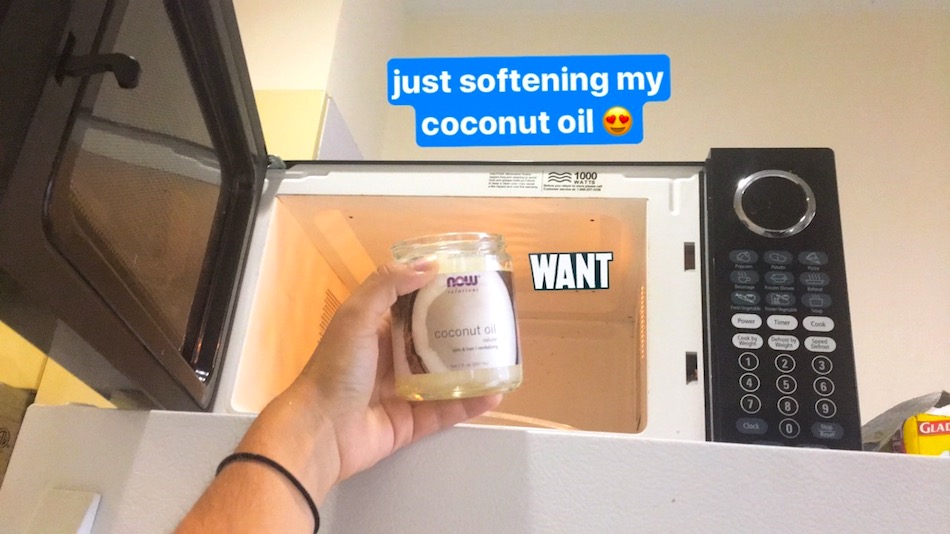
How do you use it?
For this step, I used natural coconut oil.
To prep my skin, I ran my leg under warm water. When I opened the tin, though, I quickly realized I couldn't scoop the oil at room temperature. I had to awkwardly waddle into the kitchen with a wet leg, pop the jar into the microwave for 20 seconds, then trudge back to the bathtub. After that, though, the experience was smooth-sailing: the oil spread onto my skin easily and felt soothing.
Did it work?
Yes — and really well, at that! My razor never got clogged; I simply ran it under water when I finished for a five-second rinse. Coconut oil not only allowed for a tight, clean shave, but it helped soften my skin enough for me to get rid of dry flakes. After washing off the oil, my legs felt silky smooth for the rest of the day — and not even a touch greasy!
Is it better or worse than regular shaving cream?
Personally, I preferred the oil to shaving cream. It left my skin super moisturized, and it felt significantly more natural than chemically-manufactured shaving creams. Truthfully, I’m not sure I will switch back to shaving cream after trying this!
Were there any problems?
Not really! Despite the initial microwaving incident, I can’t say there was a single issue with using the oil. It smeared on quickly and washed off easily, unlike some of the other substitutes I tried later.
Shaving Cream Substitute #3: Dish Soap
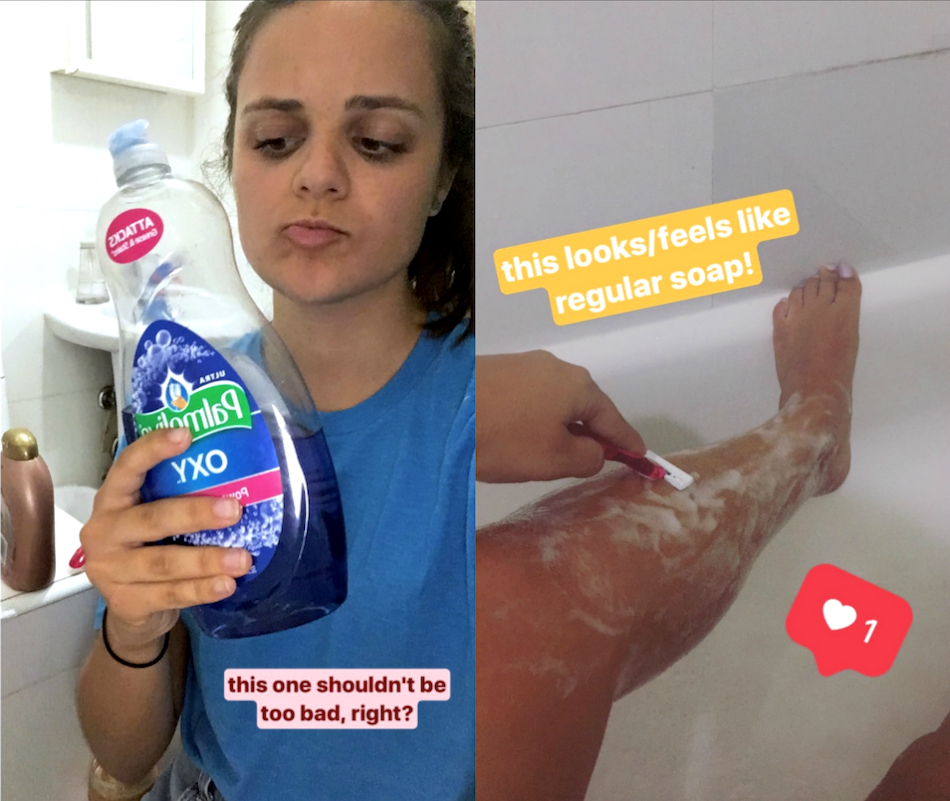
How do you use it?
For this trial run, I grabbed a bottle from the kitchen and brought it into foreign territory — the bathroom.
Applying the dish soap was incredibly easy, mainly because it felt like using regular body wash. First, I wet my legs, then I squirted the goo directly onto my shin. The experience felt all-too-familiar, probably because the soap lathered on like the bar soaps I usually use for shaving.
Did it work?
Yes! Every once and awhile, my razor got a little clogged with the thick goop, but the experience was smooth otherwise. I liked that the soap lathered so I could track my strokes and missed spots. The soap washed off fairly seamlessly, but it took a little more scrubbing than I expected to not feel slimy.
Is it better or worse than regular shaving cream?
Admittedly, I don’t think I would ever use dish soap to shave my legs again — unless I were totally desperate. A sticker on the bottle stated that the soap “attacks grease & stains;” this sounds great for my plates and pans, but I'm not sure I want this mess of chemicals all over my skin. No hard feelings, dish soap, I just think we should contain our interactions to the kitchen!
Were there any problems?
Quite a few, actually. Using dish soap had no added benefits for my skin, really, seeing that my legs felt a little dry the next morning and my stubble was already returning. It also left me smelling like a dish-drying rack, which was pretty awkward.
Shaving Cream Substitute #4: Honey

How do you use it?
The honey I chose for this part of the experiment came in a cute bear bottle.
To apply the substance, I doused my legs with warm water, squeezed out a few lines with the honey, then rubbed it in using more water.
Did it work?
Yes, but it left me feeling so incredibly sticky. As with peanut butter, there are some substances that are meant to stay in the kitchen — and honey is one of them. My skin still feels sugar-coated because the honey was so tough to wash off!
This was also the only substitute that I cut myself while using — and it happened twice! Although my general grogginess that morning probably contributed to these two nicks, I still don’t think I would ever use honey again to shave.
Is it better or worse than regular shaving cream?
Although my skin felt nourished and smelled a bit florally after the fact, I cannot say that I prefer this substitute to shaving cream. I think I am going to stick to stirring honey into my tea — not smearing it onto my skin. The teddy bear bottle is cute, though!
Were there any problems?
For sure. Besides my general discomfort with rubbing a common condiment onto my skin, issues included a frustratingly goopy razor and unnecessarily sticky skin. After fully washing the honey off, though, my leg felt super smooth and smelled excellent.
Unfortunately, this is a bit of an expensive alternative, especially considering it takes a whole lot of honey to coat your skin. Also, it would be pretty weird trying to explain a sticky shower floor to a roommate or family member — yikes! Second only to peanut butter, this was probably my least favorite of the five alternatives.
Shaving Cream Substitute #5: Aloe Vera
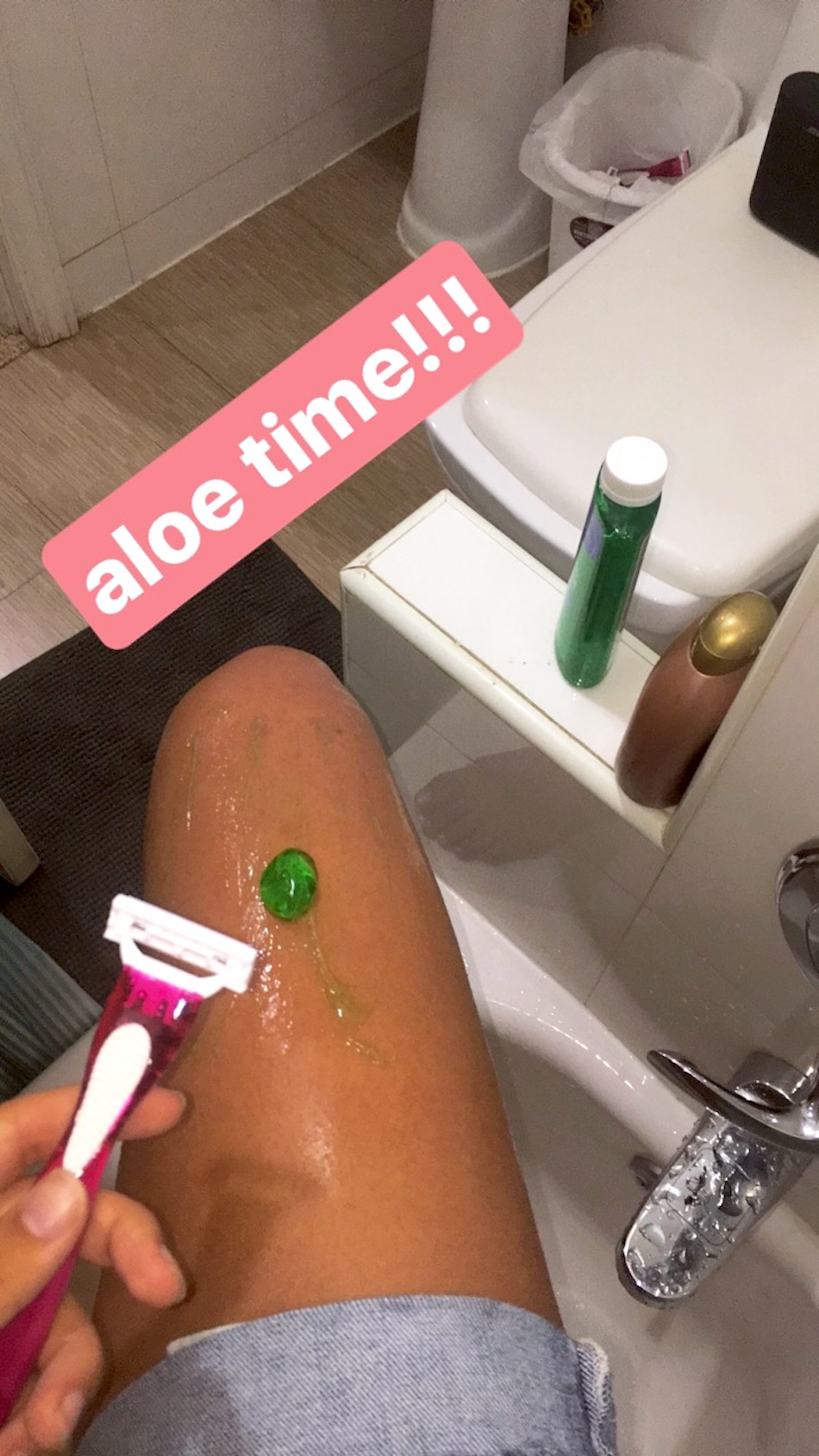
How do you use it?
I used an aloe gel for this step.
To apply the gel, I first wet my legs, then squeezed a few gobs directly onto my skin. It was kind of difficult to rub in with water already on my leg, but I would be interested to try a second time and switch the order: aloe first, water second.
Did it work?
Yep. The good news is that aloe is a pretty darn reliable when it comes to shaving and general skin soothing. The gel acted as a slick lubricant, which helped me shave off my stubble quickly and efficiently. Aloe made for a tight shave, meaning my hair hasn’t grown back to noticeable stubble yet — even 48 hours later!
Is it better or worse than regular shaving cream?
Honestly, I would say that I like using aloe vera and shaving cream about the same. A few times, I had to rinse my razor to unclog the gel, but I have the same experience with shaving cream. The goopiness was a bit obnoxious because most of the gel dripped off before I could even shave, but it wasn’t enough to forever turn me off to the idea of shaving with aloe.
Were there any problems?
A few. The Drug Facts label on the back of the bottle warned against using the gel in “large quantities,” which made me a bit skeptical of using aloe regularly for shaving. I also didn’t think the "skin relief" factor was necessary because my legs weren't burned or irritated. Overall, aloe is a reliable option if you are running out of resources, though. I would use it again, but probably only out of necessity.
Best Substitute For Shaving Cream
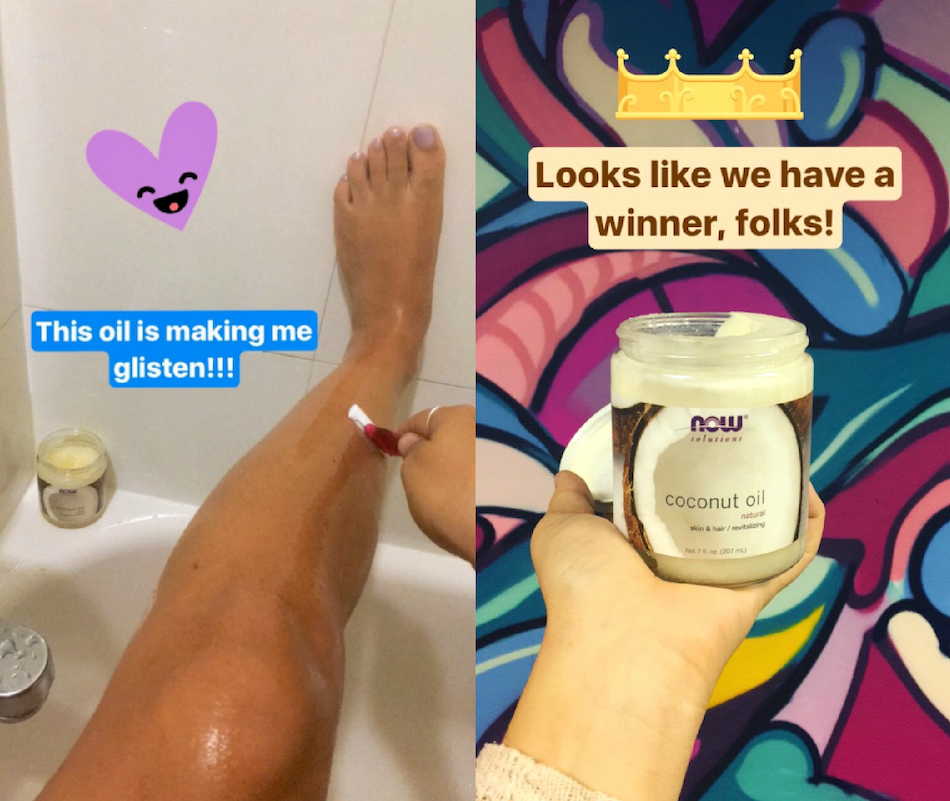
Coconut Oil
The stand-out winner was, without a doubt, coconut oil! This shaving cream alternative appealed to me the most for many reasons.
First of all, it is cost effective. I was able to purchase a tub for only $6.79 at my local grocery store, and I am confident that it will last me for at least two months. What a deal!
I was also drawn to its natural allure. Coconut oil left my skin feeling moisturized and replenished in the way that its chemical-laden counterparts did not. The back of the bottle states that the oil "contains no chemical preservatives or artificial colors, [and] no solvents are used during extraction." How refreshing is that to hear? I was not apprehensive in the slightest to rub the oil into my skin, which I can't say about all of the substitutes I tried.
Next, the oil contributed to a clean, tight shave. I didn't cut my skin once or wake up to the burning sensation of razor bumps the next day. For a girl with super sensitive skin, this is a big deal!
Finally, the coconut oil wasn't rough on my razor and was extremely easy to clean up. Washing the excess oil off of my leg only seemed to make my skin smoother!
My only true reserve with this substitute is that it can be a bit difficult to find sometimes. I recommend searching ahead of time to make sure your convenience store carries it or ordering a tub or two online.
All in all, I emerged from this experiment only willing to try two of the shaving cream substitutes again: coconut oil and aloe. To be quite honest, I think I am going to switch over to using coconut oil for good! Will you give this shaving hack a try?
Consider Not Shaving At All
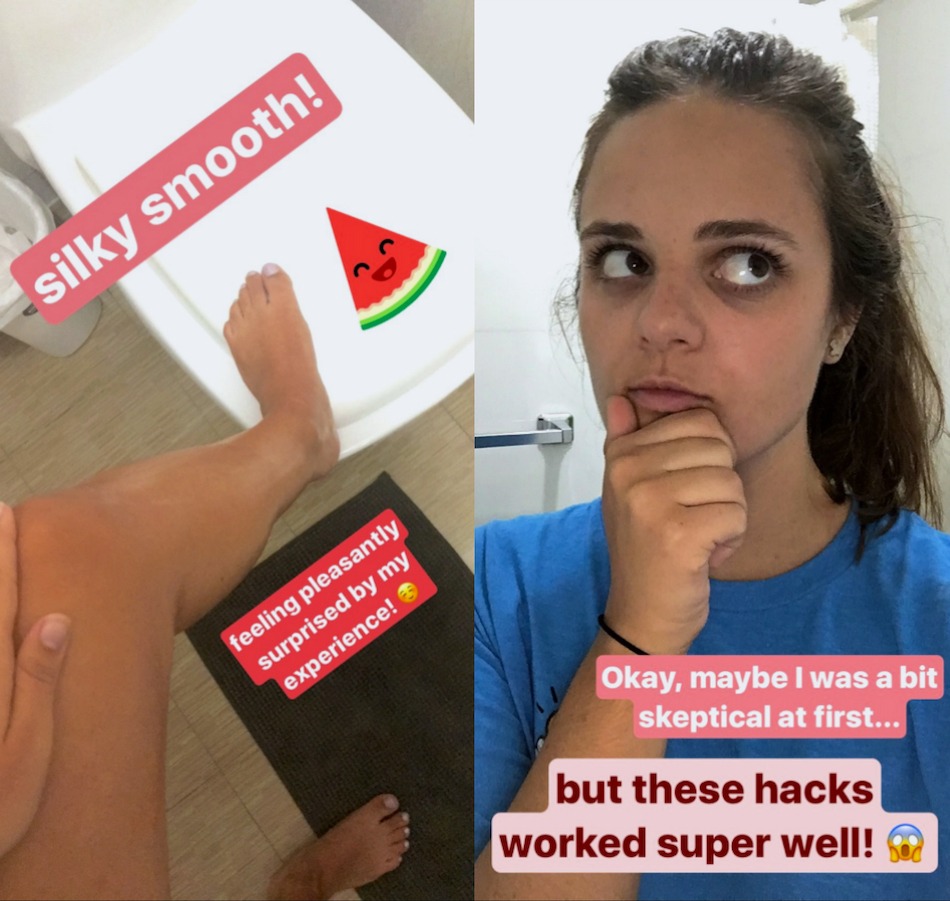
In a perfect world, humans wouldn't and shouldn't have to shave at all. As it turns out, shaving can have a lot of adverse effects on your body — especially considering body hair is a natural protectant. Giving up shaving would not only save you a ton of money and time, but it would protect your skin from unnecessary irritation and damage. And although most people don't know it, going without a shave can even boost your sex life!
That being said, I know better than anyone that ditching shaving is easier said than done. If I skip razor day, my skin breaks out with icky pustules. The trick to shaving is figuring out which method works best for you and trying to limit the practice as much as you can. Keep in mind that every time you shave your hair, you are slicing away skin, too. Make sure you are only whipping out the razor when you really need it!
Which of these shaving cream substitutes is the most appealing to you? Alternatively, which seems the most bizarre? Let us know what you think in the comments.
If you plan to test this out for yourself, make sure to SHARE this article in case anyone else might like to try, too!




